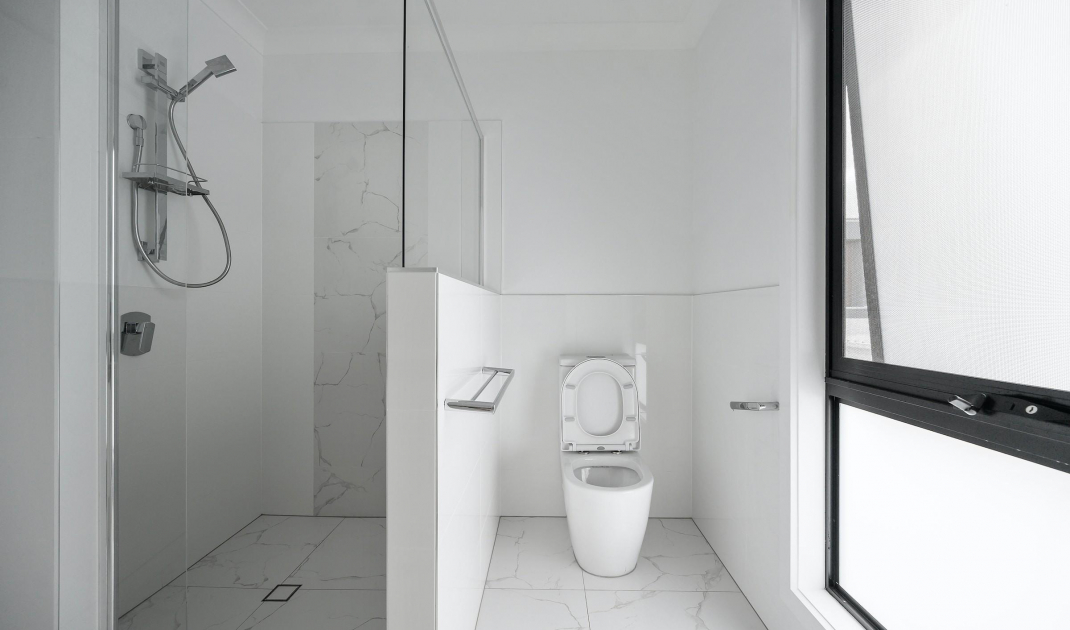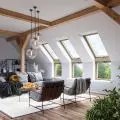Most bathrooms in today's construction industry are designed for adults and the physically fit people. However, they are used by everyone from young children to seniors with disabilities. Life situations force us to modify these rooms to meet the needs of sick parents or householders after injuries. A barrier-free bathroom should enable independence and comfortable hygiene for everyone, regardless of mobility limitations. How to arrange it? It turns out that it is not worth waiting for fortuitous events. The most important decisions must be made already at the design stage!
What dimensions should a bathroom for the disabled people have?
Which moment is the best for planning an intergenerational bathroom? The one in which you hold in your hand the plans of your future house or apartment. It turns out that a bathroom with facilities for the disabled requires the designation of adequate space and the width of the interior door. Such changes are best designed already on paper to avoid tearing down walls later.
The dimensions you need to discuss with the architect are specified in DIN 18040. According to this document, we distinguish two types of bathrooms for people with mobility disabilities:
-
a barrier-free bathroom is a room with a door opening of at least 80 cm, which must have a movement zone of at least 120 cm x 120 cm in front of the sink, toilet, bathtub or shower;
-
a wheelchair-accessible bathroom, on the other hand, has a doorway 90 cm wide and a movement zone of 150 cm x 150 cm.
However, you can start planning at an even earlier stage! Ensure that the bathroom is a room located on the first floor, and remove any barriers to access for household members and guests.
A bathroom for the disabled requires adequate space and wide doorways. Its plan should be created already at the design stage
Photo: rc-cf © Unsplash
Shower, faucet, sink - what to equip a barrier-free bathroom with?
Building without architectural barriers is slowly becoming an obvious standard. In our western neighbors, as well as in Scandinavian countries, apartments adapted to people with reduced mobility are a growing part of the market. This is very good news! Following this trend, manufacturers of bathroom fixtures are offering more and more modern solutions.
To adapt the bathroom to the needs of each family member, you will need to equip it with ergonomic and functional equipment. Check out how to do it!
Comfortable bath - shower without a shower tray
The bathtub and shower stall cause great difficulties for people with limited mobility. Therefore, the obvious choice for a barrier-free bathroom will be a shower without a shower tray. The walk-in shower area should be large enough to be accessible by wheelchair. It is important to eliminate awkward thresholds and cover the floor with a non-slip surface. There must be room for a chair or stool in the shower, and you can also install a folding seat. If you plan a shelf for shampoo and bath gel - it should also be at the right height.
Another convenience is comfortable handles, installed to make it easy to lift or transfer from a wheelchair. A cabin suitable for people with disabilities should not have a lockable door. In such showers, excess water disappears down the drain thanks to a properly shaped floor.
A walk-in shower cubicle should be large enough to allow a wheelchair to enter it comfortably. A seat or space for a shower stool is also important
Photo: cdc © Unsplash
Safe and functional shower panel
Installing a shower faucet with amenities will make a huge difference in the enjoyment of independent bathing. The shower column should be mounted at a height of 85 cm, so it can be accessed from a seated position. One-handed faucets with a convenient downward-facing lever are the best choice. Another important feature is the temperature limiter. A faucet equipped with a thermostat allows you to take a bath at a pleasant temperature and avoid dangerous burns.
The shower column should be installed at a height of 85 cm. The best choice are faucets operated with one hand
Photo Point3D Commercial Imaging © Unsplash
What kind of washbasin will work in a barrier-free bathroom?
To choose the perfect washbasin, try to run your imagination and put yourself in the shoes of a wheelchair user. You enter the bathroom to wash your hands. What is important to you? What is getting in your way?
Let's try to isolate the most important features of washbasins in rooms for the disabled:
-
Mounting at a height that allows you to wash your hands while seated. Here again, the distance of 85 cm from the floor applies.
-
Free wheelchair access. The most convenient in this situation are wall-mounted washbasins, without a cabinet underneath.
-
The contoured, slightly concave shape of the bowl, allows you to reach the tap without obstruction.
-
Concealed siphons that leave even more legroom.
-
A faucet with a high lever that can be operated with one hand.
-
A low-hanging mirror, a towel bar and space for handy accessories.
It is worth remembering that disability is not only mobility limitations, but also problems with clear vision. In such a situation, fixtures with large high-contrast markings will be perfect.
Toilet bowls dedicated to people with disabilities
Using the toilet is one of the most intimate activities of any household member, so in this regard it is worth guaranteeing everyone's independence. Let's return for a moment to the appropriate space in the bathroom. The area around the toilet should be wide enough to ensure trouble-free access in a wheelchair and on crutches. The lateral distance from the wall or other sanitary facilities is also important. DIN 18040 recommends 90 cm on one side and 30 cm on the other in wheelchair-accessible rooms. This is the place to install folding handrails to make it easier to take and maintain a position on the toilet.
In barrier-free bathrooms, toilet bowls with a gentle oval shape work best. The optimal distance from the floor is 46 - 48 cm. Such an installed paragraph allows comfortable and painless sitting down and transferring. Slightly more requirements must be met by a toilet seat adapted to such a room. Surely in hospital toilets an important detail caught your eye: toilet seats have a characteristic cutout in front. This space is supposed to ensure the convenience of hygienic activities regardless of the condition.
It is imperative to remember that the toilet seat is durable and properly reinforced. Its design should allow for long-term use regardless of high loads. Dedicated toilet seats are made of duroplast - this is a material with antibacterial properties, resembling a metal-ceramic alloy. Strong metal hinges are also standard.
The area around the toilet should be wide enough to allow easy access for wheelchair users. This is the place to install folding handrails to make it easier to use the toilet
Photo Point3D Commercial Imaging © Unsplash
How to decorate a bathroom without barriers - additional tips
True convenience is in the details. Even if you think you've decorated a bathroom perfectly suited for the elderly, injured or ill, there are bound to be a few more noteworthy amenities. At this point, it's also worth thinking about children! They, too, face daily the barriers that the adult world imposes on them.
Check out what else you can do to make your bathroom a space without exclusions:
-
Install smart lighting. It's a small investment that becomes a huge convenience for anyone who has to enter a completely dark restroom at night.
-
Low bathroom furniture is a nod to wheelchair users, but also to the youngest family members. Easy access to clean towels, extra rolls of paper and cleaning products will allow all household members to be more independent.
-
Install the flush actuation button next to the toilet, rather than above it. This will make it much easier to operate for people who find it difficult to raise their hand high.
-
In many bathrooms, touchless fixtures, in which the water jet is activated by a motion sensor, are an excellent solution. While the classic hand towel can be replaced by a hair dryer.
Remember also that a bathroom with amenities can still be a beautiful and stylish room! On our portal you will find many sample arrangements from top architects.
A bathroom without barriers can still be a beautiful and stylish room! Look for inspiration in the numerous articles about bathrooms on our portal
Photo by Max Rahubovskiy © Pexels
Is a bathroom with special adaptations needed in every home? We wish you didn't have to think about such a room for as long as possible. However, even healthy and physically fit people have to face limitations at certain stages of life. As we well know, an unexpected skiing injury, a difficult delivery or a chronic infection take away your strength and force you to rely on assistance. Do your best to take care of your own hygiene even in such situations.
Are you decorating your apartment? We have more bathroom inspirations for you!
































